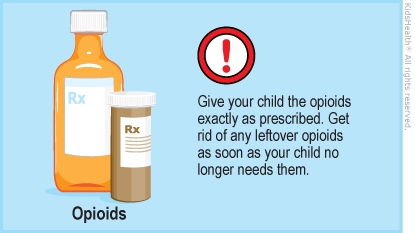Prescription Pain Medicines: How to Give Them to Your Child Safely
When your child's health care provider prescribes pain medicines, it is important to know how to use, store, and get rid of them safely.


Kids sometimes need help controlling pain for a short period of time after surgery or a procedure. Often, an over-the-counter (OTC) pain medicine works well, but a prescription pain medicine may be needed for severe pain. Prescription pain medicines usually contain an opioid. Opioids work by blocking pain messages from reaching the brain.
Health care providers carefully figure out the right dose of medicine for a patient. When the medicine is taken exactly as prescribed, it should relieve pain symptoms. Taking too much medicine could be very dangerous. It can make someone breathe too slowly, which can lead to death. If a person is pregnant, she should not take prescription pain medicine unless absolutely necessary because it could cause serious health problems in the baby.
Pain medicines prescribed by health care providers for necessary use sometimes do lead to addiction and overdose if taken differently from how they are prescribed. If you have prescription pain medicines in the home, you should know about the risks of addiction and overdose.
It's your responsibility to carefully give the right dose and make sure that your child is the only person who takes the medicine. You also must not allow family, friends, or visitors to use your child's medicine.

Picking Up the Medicine
-
Tell the pharmacist if your child takes a medicine (a benzodiazepine) for anxiety, seizures, or muscle spasms. Common brand names include Valium®, Ativan®, or Xanax®.
-
Also tell the pharmacist about any other medicines, herbs, or supplements your child takes.
-
If you have any questions about how to give the medicine, talk to the pharmacist.
Dosing
-
Follow your health care provider or pharmacist's advice about which medicines your child can continue to take while on prescription pain medicine. Taking some medicines along with prescription pain medicines can lead to serious health problems.
-
You or another responsible adult should give the pain medicine exactly as you were instructed by the health care provider.
-
Don't give more medicine than prescribed.
-
Don't give the medicine more often than prescribed.
-
If another adult will be giving your child the medicine, carefully review the dosage instructions with him or her.
-
Never tell kids that medicine "tastes like candy."
-
If your child is a teen, don't allow him or her to drink alcohol. This is especially dangerous while taking prescription pain medicines. Drinking alcohol while taking prescription medicines can lead to serious medical problems, even death.
-
Be sure to ask the health care provider or pharmacist before also using acetaminophen or ibuprofen. Some prescription pain medicines contain similar ingredients and taken together could cause your child to get too much medicine.
-
Pain medicine can make it difficult to do some activities that call for being alert. Don't let your child ride a bike, swim, use a lawnmower, or drive while taking the medicine.
Storage
-
After giving your child a dose of the medicine, close the lid tightly and put it away in a locked cabinet, out of the reach of children, visitors, and pets. Don't leave it out on the table or countertop.
-
Store the medicine in the container it came in.
-
Keep track of how much medicine is in the container.
Getting Rid of Unused Medicine

-
You have questions about when or how to give the medicine.
-
Your child has pain even after taking the pain medicine.
-
Your child has side effects, such as:
-
constipation
-
sleepiness
-
itching
-
nausea or vomiting

-
Your child is very sleepy.
-
Your child has vomiting that doesn't stop.
-
You think your child took too much medicine.
-
Your child has slow breathing.
Call 911 if you can't wake up your child.

What opioid pain medicines are prescribed for kids and teens? Opioid pain medicines prescribed for kids and teens include:
-
hydrocodone with acetaminophen liquid (Hycet®) and pills (Vicodin® and Lortab®)
-
oxycodone with acetaminophen liquid (Roxicet®) and pills (Percocet®)
-
hydromorphone liquid and pills (Dilaudid®)
-
morphine liquid and pills
-
oxycodone liquid and pills
-
others – ask your health care provider if your child is prescribed an opioid pain medicine that is not on this list
What else should I know about opioids? Have conversations with your kids about using medicines safely. Tell your older child or teen that prescription pain medicines are only safe when prescribed by a health care provider and can be dangerous or addictive if used in any other way.
How can I get help for someone with a substance abuse problem? Call SAMHSA's National Helpline at 1-800-662-HELP (4357). This free and confidential service is available in English and Spanish.